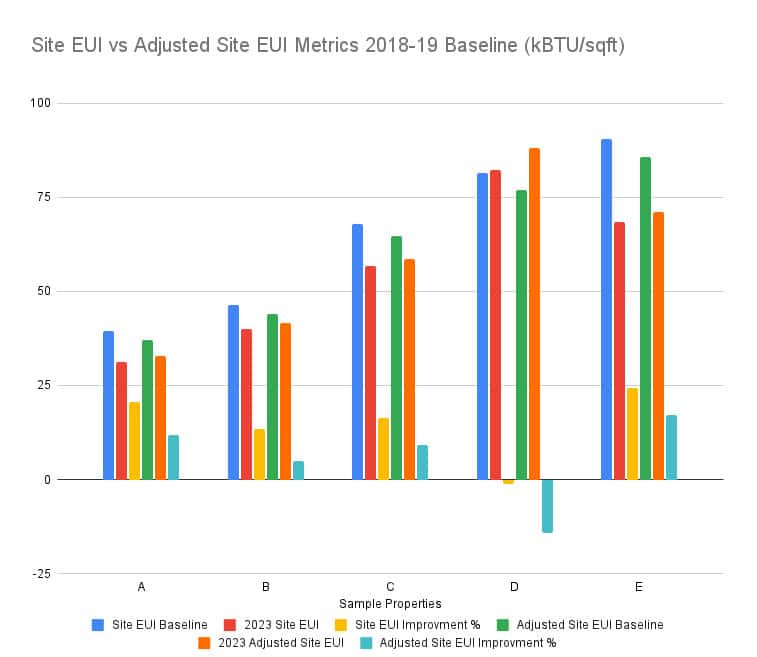For buildings benchmarked under the District of Columbia’s Building Energy Performance Standards (BEPS), understanding the difference between Site EUI and Adjusted Site EUI in Energy Star Portfolio Manager (ESPM) is critical. Many property owners following the Performance Pathway or the Extended Deep Energy Retrofit (EDER) pathway may be surprised to learn that adjusting their Site EUI to reflect current-year weather conditions has negatively impacted their compliance status.
What Is Site EUI vs Adjusted Site EUI?
Site Energy Use Intensity (Site EUI) is a measure of a building’s energy consumption per square foot per year. Adjusted Site EUI, on the other hand, normalizes this figure based on the most recent 12 months of weather conditions, effectively removing the impact of temperature fluctuations from the equation. The purpose of this adjustment is to ensure that extreme weather years do not unfairly influence compliance calculations. Similarly, it also re-adjusts past figures based on changes to the building’s occupancy, such as the number of full time workers. Occupancy conditions in multifamily buildings rarely change significantly, by the nature of their use. Because weather conditions affects all buildings equally, unlike occupancy or building use, this article will exclude changes in building occupancy for the purpose of its analysis and only focus on weather normalization.
How Does This Adjustment Impact Compliance with DC BEPS?
For properties benchmarked in DC, adjusting Site EUI to the most recent 12 months of weather data (from February 2025) resulted in making compliance with BEPS more difficult. On average, properties lost 8.5 percentage points in their progress toward achieving the 20% EUI reduction goal. In practical terms:
- A property that believed it had reduced its Site EUI by 21% may find that its Adjusted Site EUI reduction is only 12.5%.
- This means that instead of being in compliance, the property could now be subject to 37.5% of its maximum penalty ($10 per square foot).

Why Did This Happen?
The baseline years of 2018 and 2019 were relatively extreme in terms of weather conditions, meaning they had higher heating and cooling demands compared to the current year. When ESPM adjusts Site EUI to the most recent 12 months weather conditions, the baseline EUI is lowered to reflect milder recent weather. Lowering the baseline energy usage makes it more difficult to show a 20% reduction, effectively reducing the apparent progress toward compliance with BEPS.
Why Does DOEE Adjust for Weather?
The DC Department of Energy and Environment (DOEE) applies this weather adjustment to ensure fairness over time. If an extreme weather year occurs in 2026, it will not disproportionately inflate a property’s Adjusted Site EUI compared to its baseline year, ensuring that buildings are not unfairly penalized due to external weather conditions.
Monthly Recalculations: A Key Consideration
One critical nuance is that ESPM defines the “current year” as the previous 12 months on a rolling basis. This means that:
- Adjusted Site EUI figures must be recalculated every month.
- All previously recorded Adjusted Site EUI values change every month as historical data is re-normalized.
- However, the percent difference between two years remains constant once the initial adjustment is made. If a building’s Adjusted Site EUI was reduced by 12.5% in January, it will still show a 12.5% reduction in February, even though the raw EUI values may shift slightly.
Montgomery County’s BEPS and Normalized Site EUI
Montgomery County, Maryland’s BEPS program uses Weather Normalized Site EUI, which functions similarly to Adjusted Site EUI. This metric ensures that weather-related fluctuations do not distort compliance progress. However, it does not take into consideration changes in building occupancy or use.
What Should Buildings Do?
Any property on the Performance Pathway under DC BEPS or subject to Montgomery County’s BEPS should:
- Ensure their ESPM reports reflect Adjusted Site EUI or Normalized Site EUI rather than just Site EUI.
- Recalculate their progress regularly to account for ESPM’s monthly updates.
- Contact Honeydew Energy Advisors for guidance on tracking the correct metrics and ensuring compliance.
If your reports are not showing progress in Adjusted Site EUI, reach out to Honeydew Energy Advisors. We can provide key insights into the metrics you should be monitoring to stay on track for compliance.

